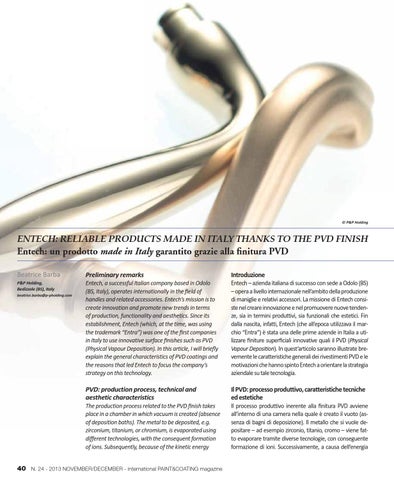© P&P Holding
ENTECH: RELIABLE PRODUCTS MADE IN ITALY THANKS TO THE PVD FINISH Entech: un prodotto made in Italy garantito grazie alla finitura PVD Beatrice Barba
Preliminary remarks
Introduzione
P&P Holding, Bedizzole (BS), Italy
Entech, a successful Italian company based in Odolo (BS, Italy), operates internationally in the field of handles and related accessories. Entech’s mission is to create innovation and promote new trends in terms of production, functionality and aesthetics. Since its establishment, Entech (which, at the time, was using the trademark “Entra”) was one of the first companies in Italy to use innovative surface finishes such as PVD (Physical Vapour Deposition). In this article, I will briefly explain the general characteristics of PVD coatings and the reasons that led Entech to focus the company’s strategy on this technology.
Entech – azienda italiana di successo con sede a Odolo (BS) – opera a livello internazionale nell’ambito della produzione di maniglie e relativi accessori. La missione di Entech consiste nel creare innovazione e nel promuovere nuove tendenze, sia in termini produttivi, sia funzionali che estetici. Fin dalla nascita, infatti, Entech (che all’epoca utilizzava il marchio “Entra”) è stata una delle prime aziende in Italia a utilizzare finiture superficiali innovative quali il PVD (Physical Vapour Deposition). In quest’articolo saranno illustrate brevemente le caratteristiche generali dei rivestimenti PVD e le motivazioni che hanno spinto Entech a orientare la strategia aziendale su tale tecnologia.
PVD: production process, technical and aesthetic characteristics
Il PVD: processo produttivo, caratteristiche tecniche ed estetiche
The production process related to the PVD finish takes place in a chamber in which vacuum is created (absence of deposition baths). The metal to be deposited, e.g. zirconium, titanium, or chromium, is evaporated using different technologies, with the consequent formation of ions. Subsequently, because of the kinetic energy
Il processo produttivo inerente alla finitura PVD avviene all’interno di una camera nella quale è creato il vuoto (assenza di bagni di deposizione). Il metallo che si vuole depositare – ad esempio zirconio, titanio, cromo – viene fatto evaporare tramite diverse tecnologie, con conseguente formazione di ioni. Successivamente, a causa dell’energia
beatrice.barba@p-pholding.com
40 N. 24 - 2013 NOVEMBER/DECEMBER - international PAINT&COATING magazine
